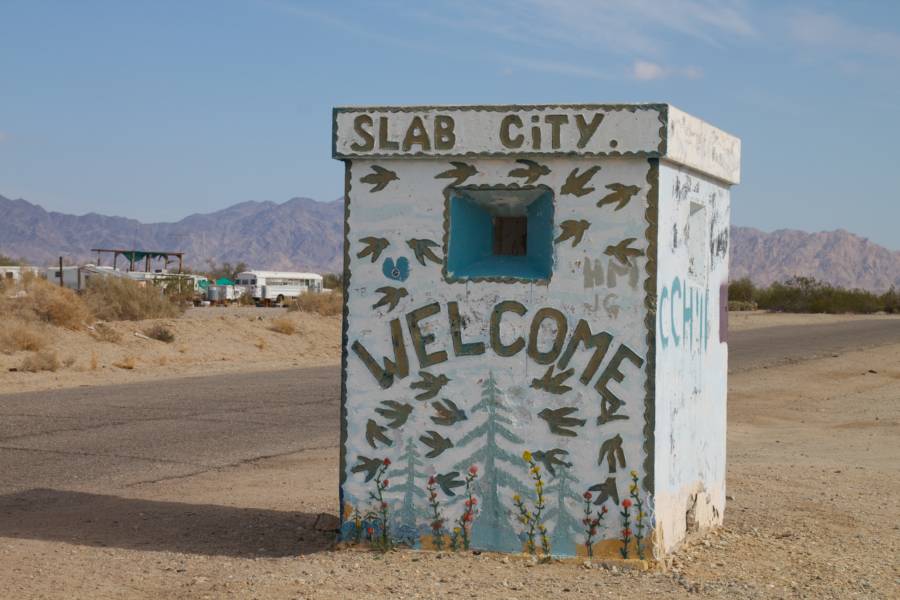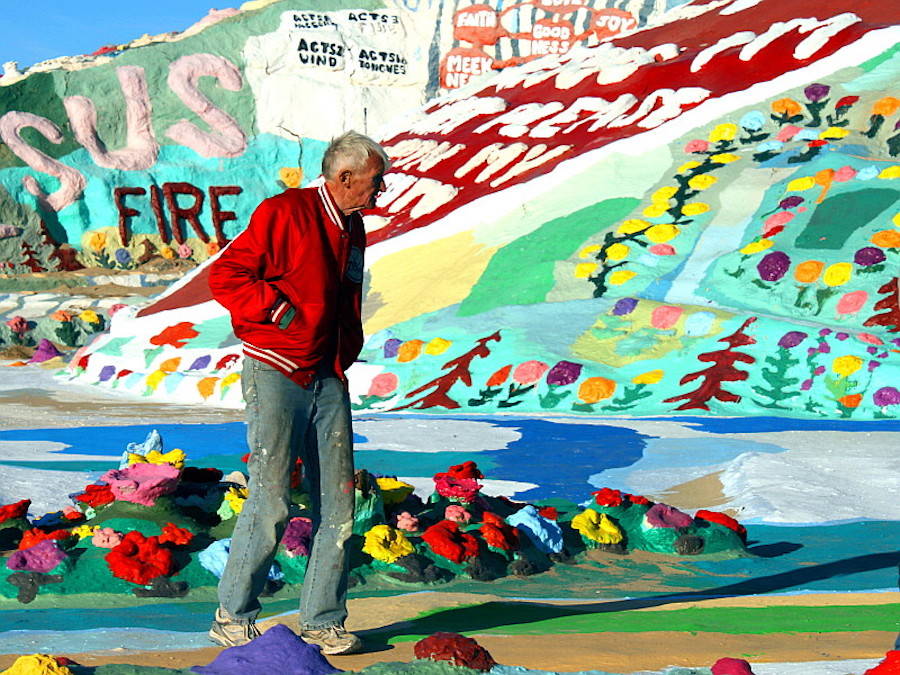It's far from glamorous, but an eclectic group of people call Slab City home.

tuchodi/FlickrA sign welcoming visitors to Slab City.
Built on an abandoned military base in the middle of California’s Sonoran Desert, Slab City doesn’t have many modern amenities. No power lines or pipes carry electricity or fresh water to the city. Residents have to sort out their own system for disposing of sewage or trash.
But to those who call the community home, Slab City offers something even more important than comfort: freedom.
The Founding Of Slab City
Slab City was born when the U.S. Marine Corps abandoned Fort Dunlap, a military installation near the town of Niland. They dismantled the buildings in 1956 but left behind the concrete slabs that served as their foundations. Though California officially regained control over the land, it was too remote and inhospitable for the state to really concern itself with.
But when employees from a chemical company working near Niland found the slabs, they decided it was the perfect spot to erect a temporary settlement close to their job site. The small trailers they brought with them became the beginnings of the new community of Slab City.
Over the next few decades, people from outside the area were drawn to the improvised city. To this day, the residents remain a motley collection of the poor, snowbirds, and people looking for a way to live off the grid.
In this forgotten place, there are no property taxes or utility bills, which makes it ideal for people trying to stretch their pensions or Social Security checks. Even today, Slab City’s population swells to over 4,000 during the cooler winter months as people come down from as far away as Canada to take advantage of the warmer temperatures and cheap living.
undmark/Flickr
When the summer heat sets in and temperatures rise to 120 degrees, most return to their homes, leaving a smaller permanent population of about 150.
Life In California’s Sonoran Desert
Becoming a resident of Slab City is an informal process. You simply show up, find a patch of land that no one else has claimed, and set up a trailer, shack, yurt, or truck.
But living in the community requires a certain degree of self-reliance.
The nearest public amenities – including drinkable water – are in Niland a few miles away. Residents share a single communal shower fed by a nearby hot spring. Most people in the community rely on their own technical expertise to handle the rest.
If you want electricity, you have to set up a collection of solar panels, generators, and batteries. Or you can hire “Solar Mike,” a long time Slabber who has been selling and installing solar panels out of his trailer since the 1980s.
Though police from Niland occasionally patrol the area and will respond to emergency calls, the community largely polices itself.
Living in Slab City requires adhering to a certain code of behavior. While drug use is common, residents say that it’s usually confined to certain well-known areas of the camp. The most common type of crime is theft. Typically, there aren’t reports of vigilante violence in response to crime, but the community will shun people who are suspected of misbehavior.
As one Slabber, George Sisson, who runs an Airbnb in the community, explains, “Here you don’t mess with people’s business unless they steal your shit.”
Altogether, Slab City is as close to a self-governing commune as you’re likely to find in the U.S. The most common problem people in the community report is simple boredom, which makes sense given that they’re living in the middle of the desert.
Some find solace in the simple life. Others have banded together to provide some escape from the monotony. Slab City has its own community and event center named The Range.There’s also an internet cafe that basically amounts to a tent with a wireless router inside. But residents can use the connection to download entertainment.

Alessandro Valli/FlickrThe Range at Slab City.
Art is also an important part of life in Slab City. One of the most popular attractions is Salvation Mountain, a collection of rocks covered in hundreds of thousands of gallons of latex paint and decorated with a large cross and religious messages. It’s the life’s work of one of Slab City’s most famous residents, Leonard Knight.
Knight came to Slab City from Vermont, where he had lived off a variety of odd jobs that involved welding and painting. Knight arrived in the community in the 1980s with a hot air balloon in tow. Originally, his plan was to use the community as a base for a transcontinental balloon trip. But after the balloon refused to float, he decided to put down roots instead.
Over the next few decades, he built Salvation Mountain as a monument to his faith. For Knight, Slab City was the perfect place to practice the philosophy he lived by: “Love Jesus and keep it simple.” Knight died in 2014, but he has remained a revered figure in the community.

Chuck Coker/ FlickrLeonard Knight in front of Salvation Mountain.
Another important site is East Jesus, which functions as an art collective where residents display their own sculptures and art installations. Most of them are made from recycled materials, demonstrating the residents’ ideal of self-sustainability. This kind of unique art from people on the fringes of society is part of the community’s unique appeal.
Legal Challenges To Slab City
But for a society that has long existed on the outer edges of the law, the future looks far from certain. In 2015, the state of California considered dividing the land the community sits on and selling it to private companies. Though nothing came of the proposal, it signaled how fragile the community’s position was.
That has led many residents to worry that Slab City’s days are numbered. And with it, they see the possible end of “the last free place in America.”

Dan Lundmark/FlickrThe entrance to East Jesus.
2 comments:
Eclectic seems like a good word to describe the area and its people. I didn't realize that such a 'community' would exist without some level of government 'oversight'. It also takes a specific kind of person to thrive in such surroundings. Interesting!
The no government is what makes it interesting for sure. I guess two things , one is that people like animals learn to live together and make there own rules to get along, but the standards that we have come to expect are not met.
Maybe we expect two high a standard with out reason, but standards require discipline and most people don't want discipline.
Post a Comment